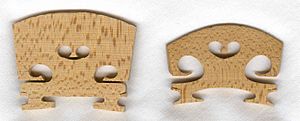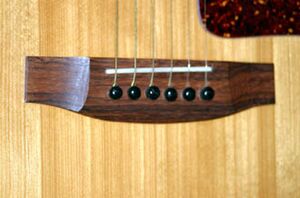Bridge (instrument) facts for kids
For other meanings, see Bridge (disambiguation).
A bridge on a string instrument is a small but very important part. It sits on the instrument's body and holds up the strings. The bridge helps send the vibrations from the strings to the main part of the instrument. This makes the sound loud enough for us to hear.
Contents
How Bridges Work on String Instruments
The Violin Family Bridge
Instruments like the violin, viola, cello, and double bass have bridges you can see easily. These bridges are made from a strong wood called hardwood. They are shaped like a small arch on top. This arch shape helps the musician play one string at a time without hitting the others.
The bottom parts, or "feet," of the bridge are carefully shaped. They fit perfectly onto the curved front of the instrument, which is sometimes called the "belly." What's interesting is that the bridge is not glued or fixed to the instrument. It stays in place only because the strings are pulled very tight. This tightness is called "tension."
The Role of the Soundpost
Inside the body of violin-family instruments, there is a small wooden stick called a soundpost. This soundpost also stays in place because of the tension from the strings and the bridge. The soundpost helps carry the vibrations from the top of the instrument to the back, making the sound richer and louder.
How Strings Vibrate
The part of the string that vibrates to make a musical note is the section between the bridge and where the musician presses their finger on the fingerboard. The other end of the string is attached to a part called the tailpiece.
Bridges on Other Instruments
On a banjo, the bridge works in a similar way to those on violins. However, on a guitar, the bridge is usually fixed firmly to the instrument. The strings are then attached directly to this fixed bridge.
Some instruments even have bridges that can be moved. For example, the Japanese koto has a separate, movable bridge for each string. This allows musicians to change the pitch of each string by moving its bridge.
Images for kids
-
On a cello, the strings are attached to the tailpiece and are held above the soundboard by the bridge.
See also
 In Spanish: Puente (instrumento musical) para niños
In Spanish: Puente (instrumento musical) para niños





